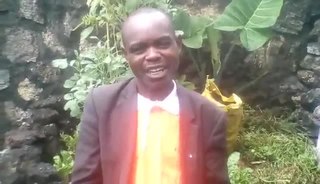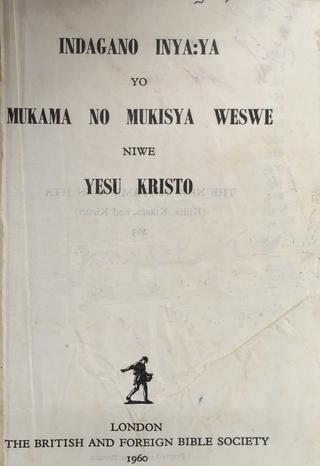Related Research Articles
Basaa, or Mbene, is a Bantu language spoken in Cameroon by the Basaa people. It is spoken by about 300,000 people in the Centre and Littoral regions.
Myene is a cluster of closely related Bantu varieties spoken in Gabon by about 46,000 people. It is perhaps the most divergent of the Narrow Bantu languages, though Nurse & Philippson (2003) place it in with the Tsogo languages (B.30). The more distinctive varieties are Mpongwe (Pongoué), Galwa (Galloa), and Nkomi.
The lhukonzo (Konzo) language, variously rendered Lukonzo, Olukonzo, and konzo, is a Bantu language spoken by the Konzo people of Uganda and the Democratic Republic of the Congo. It has a 77% lexical similarity with Nande. There are many dialects, including Sanza (Ekisanza).
Bila, or Forest Bira, is a Bantu language spoken in the Mambasa Territory of the Democratic Republic of Congo. It is also spoken by the Mbuti Pygmies who live in that area. Pygmy groups to the west include the Kango and Sua (Batchua). Other Mbuti speak Central Sudanic languages. The Kango and Sua speak distinct dialects, but not enough to impair mutual intelligibility with their farming Bila patrons.

Lega is a Bantu language, or dialect cluster, of the Democratic Republic of the Congo. There are two major varieties, Shabunda Lega and Mwenga Lega; Mwenga Lega, with about 10% of speakers, finds Shabunda difficult to understand. Kanu has been assigned a separate ISO code but is a dialect of Shabunda, and no more divergent than other dialects.
Yans (Yanzi) is a Bantu language spoken in the Democratic Republic of the Congo by the Bayanzi.
Ndemli, or Bandem, is a language of Cameroon spoken primarily in the Nkam department of the Littoral Region; between Yabassi, Yingui and Nkondjock. Recent classifications such as Nurse (2003) place it in with the Narrow Grassfields languages, though Ethnologue does not reflect this. Ethnologue states that it is "related to Tikar" and that "the Bandobo dialect of Tikar is very similar to Ndemli", though it is not clear if Bandobo actually is Tikar.
Nyiha is a Bantu language primarily spoken in Tanzania and Zambia. The language of the 10,000 speakers in Malawi is different enough to sometimes be considered a distinct language.
Lala-Bisa is a Bantu language of Zambia that is closely related to Bemba.

Jita is a Bantu language of Tanzania, spoken on the southeastern shore of Lake Victoria/Nyanza and on the island of Ukerewe.
Songo (Nsongo) is a Bantu language of Angola. It is similar to North Mbundu, and is often considered a dialect of that language. The true relationship may be a regional influence since it has been suggested that Nsongo and Teke, and its relatives, are close.
Kuba is a Bantu language of Kasai, Democratic Republic of Congo.
Holoholo is a Bantu language of DR Congo and formerly in Tanzania spoken by the Holoholo people on either side of Lake Tanganyika. Classification is uncertain, but it may belong with the Takama group.
Lwalu, also known as Lwalwa, is a Bantu language of the Democratic Republic of the Congo. Its classification is uncertain: Nurse (2003), following Ahmed (1995), assigns all of Guthrie's L.20 languages to Luban, including Lwalu.
Bango, is a Bantu language spoken in the Democratic Republic of Congo. Ethnologue suggests it may be a dialect of Budza, but Nurse & Philippson (2003) list it as one of the Bwa languages.
Binji is a Bantu language of eastern Democratic Republic of the Congo. Maho (2009) states that it is close to Songe, which is otherwise isolated within the Luban languages established by Ahmed (1995).
Mashi (Kamaxi), or Kwandu, is a Bantu language of Zambia and Angola. It was assigned by Guthrie to Bantu group K.30, which Pfouts (2003) established as part of the Kavango–Southwest branch of Bantu. Though not specifically addressed, Mashi may be in that family as well.
Ndombe (Dombe) is a Bantu language of Angola. It was assigned by Guthrie to Bantu group R.10, which apart from Umbundu Pfouts (2003) established as part of the Kavango–Southwest branch of Bantu. Though not specifically addressed, Ndombe may be in that branch as well.
Suku is a Bantu language of the Democratic Republic of the Congo.
Vidunda (Chividunda) is a Bantu language spoken along the north bank of the Ruaha River in Tanzania. It belongs to the Ruvu branch of Northeast Coast Bantu.
References
- ↑ Tongwe at Ethnologue (18th ed., 2015) (subscription required)
Bende at Ethnologue (18th ed., 2015) (subscription required) - ↑ Jouni Filip Maho, 2009. New Updated Guthrie List Online
- ↑ Nurse, Derek; Philippson, Gérard, eds. (2003). The Bantu languages. London: Routledge. ISBN 9780700711345.
- 1 2 3 Abe, Yuko (2006). "A Bende Vocabulary". Bantu Vocabulary Series (13). Research Institute for Languages and Cultures of Asia and Africa (ILCAA), Tokyo University of Foreign Studies.